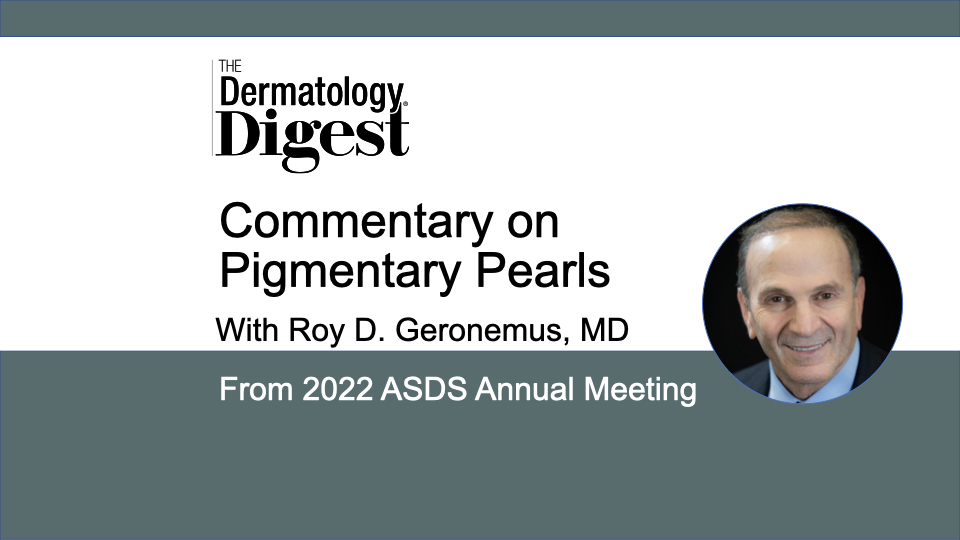Dr. Roy G. Geronemus discusses how laser technology has evolved to safely and effectively treat common pigmentary concerns.
Roy D. Geronemus, MD, Director, Laser & Skin Surgery Center of New York in New York City and Clinical Professor of Dermatology, New York University Medical Center
“The topic that I presented at the recent ASDS meeting was on using lasers for pigmentation. This includes sun damage, birthmarks, post-inflammatory hyperpigmentation, and melasma,” said Roy G. Geronemus, MD, who presented “Pigmentary Pearls” at this year’s ASDS Annual Meeting in Denver, Colorado.
When treating solar lentigines on the face and body, Dr. Geronemus said he most commonly uses Q-switched ruby, Q-switched Nd:YAG, or picosecond lasers. He might mix and match, depending on the skin phototype of the patient.
“I’m much more likely to use the Q-switched laser, typically the ruby laser 755 nm and sometimes the YAG 1064, to treat lentigines in patients with lighter skin types. I would say phototypes 1 through 3.”
The big news is the ability to use these lasers to safely and effectively treat solar lentigines in patients with darker skin types, said Dr. Geronemus.
“In darker skin types, I will often use the picosecond laser 532 nm and very gently treat those lesions so I don’t create too much thermal injury, which could exacerbate the problem and lead to post-inflammatory hyperpigmentation.”
Advances in the treatment of lentigines with 532 nm picosecond laser technology have improved outcomes in general for darker skin types, including for Asian patients who commonly present with lentigines, according to Dr. Geronemus.
“Not all picosecond lasers are the same, but if you’re using a high energy laser and you use it cautiously, you can get very nice responses.”
For treating diffuse post-inflammatory hyperpigmentation in patients with Asian or Hispanic darker skin types, Dr. Geronemus said he uses the picosecond laser in conjunction with a low energy, low density nonablative fractional 1927 nm thulium or diode laser.
“This is a nice option to treat someone who has been resistant to treatment over the years. We’re now very comfortable in treating patients with post-inflammatory hyperpigmentation, both from spontaneous injury and secondary to previous procedures.”
Dr. Geronemus is so confident in today’s laser treatment for post-inflammatory hyperpigmentation in patients with darker skin types that he treats even patients with phototype 6 skin, he said.
Laser-assisted Drug Delivery
Dr. Geronemus is using laser-assisted drug delivery, where he applies topical lightening agents in conjunction with laser treatment or immediately following, he said.
“Based on studies that were done at our practice, the channels that are opened by even nonablative fractional lasers are enough to allow penetration of topical lightening agents—in particular, tranexamic acid solution—over the treated area. This can help lighten the lesion quite dramatically.”
The Melasma Challenge
Melasma is not curable but there are ways to treat it, according to Dr. Geronemus.
“I think this has changed quite dramatically with low energy, low density nonablative fractional lasers, whether the thulium or diode laser, 1927 nm, in conjunction with topical application of tranexamic acid. Of course, one needs sun protection, and we sometimes add oral tranexamic acid. The combination of oral tranexamic acid with laser treatment plus topicals is a notable advance in the treatment of melasma, which has been a significant challenge for dermatologists, historically.”
Laser Treatment and Pigmented Birthmarks
Laser treatment of Nevus of Ota has improved since Dr. Geronemus reported on his experience with the first Q-switched ruby laser in the U.S. in 1991, he said.
“We are now treating infants at birth or shortly after birth, and we find that we can do so safely and effectively using a Q-switched laser or picosecond laser.”
Picosecond lasers have improved to the point where dermatologists can treat Nevus of Ota more easily in skin of color, said Dr. Geronemus.
“Most Nevus of Ota patients do have skin of color, which is much more common in the Asian population. But even among the phototypes 5 and 6, [outcomes with] the 1064 nm picosecond laser are quite dramatic, and it is very safe to do.”
Beginning the intervention in early infancy can make a big difference for these children because they don’t have to grow up with the condition, said Dr. Geronemus.
“It does require multiple treatments. These lesions are most commonly around the eyes, so you have to use a protective metal ocular shield under the eyelids.”
Treating café-au-lait macules can be difficult in some patients and easier in others, said Dr. Geronemus.
“The café-au-lait macules that do best (I published on this in JAMA Dermatology a few years ago)1 are the ones with irregular borders where there is a darker contrast between the lesion itself and the actual skin type of the patient. So, if I see somebody come in with a rounded or oval café-au-lait macule, they’re not going to do as well as somebody coming in with a jagged lesion. And you do see a nice response in those patients, although it may not be a long-term cure and may require some touching up.”
Lasers have not been overly effective in the treatment of congenital nevi, according to Dr. Geronemus.
“Lasers can lighten congenital nevi and improve their appearance, removing the hypertrichosis of the congenital nevus. But it is not the standard of care necessarily in the management of most nevi, although I can get some success in treating junctional nevi in many cases.”
Reference:
- Belkin DA, Neckman JP, Jeon H, et al. Response to Laser Treatment of Café au Lait Macules Based on Morphologic Features. JAMA Dermatol. 2017 Nov 1;153(11):1158-1161. doi: 10.1001/jamadermatol.2017.2807. PMID: 28854299; PMCID: PMC5817474.


